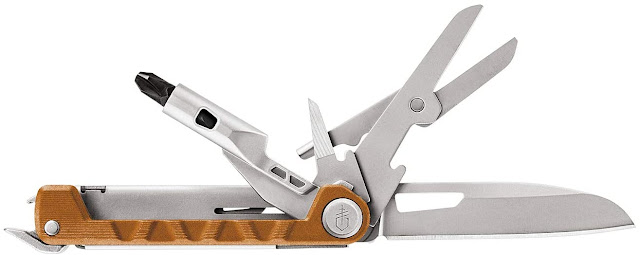I've been carrying some variety of a Swiss Army Knife for going on 30 years. I started with a
penknife as a small boy, upgrading to a couple other varieties before settling into the
Victorinox Tinker I've carried for the past 15 years or more. My dad carries one, my grandfather carried one, and millions of other folks do every day as well. They're a solid, simple, affordable tool that is popular for a reason.
With all that said about them, the Swiss Army Knife (or SAK for brevity) has some weaknesses: They can get overly complicated in a hurry, many of the tools are less-than-ideal compromises, and the blades are rather lacking. They're thin, short, and with an odd profile. They serve average users fairly well, but they fall down a bit when called on for more intense tasks.
Enter the Gerber Armbar Drive. It comes across as both stripped-down and a bit futuristic. It has an open frame and a single aluminum scale to protect it from everything else that rides in your pocket, and has almost exactly the same dimensions as the Tinker is it replacing. It doesn't have all of the tools a Swiss Army Knife carries, but it takes the most useful ones and implements them far better.
Starting with the knife itself, we have a Wharncliffe profile blade designed to be opened with one hand and with a thicker and stronger construction than the traditional SAK blade. The blade is the only tool on that side of the knife, allowing for stout construction and lockup. It also uses a liner lock for enhanced safety.
The opposite side of the tool contains a pair of very functional scissors, a short awl, and the screwdriver that gives the tool the name "Drive." Each of these tools features a hook on the spine for easy individual opening.
- The scissors have extra long blades compared to most multitools, and fit and slice tightly.
- The awl is short and sharp, and constructed in such a way that it can be easily resharpened, unlike traditional SAK awls.
- The screwdriver is a 1/4" hex bit holder that comes with a Phillips/Slotted driver bit. It has a magnet to hold the bit and can take any 1/4" screwdriver bit.
- My only concern with this tool is that the magnetic bit holder feels a touch fiddly, like the bit may fall out at some point.
On the end opposite the tools is a folding tool steel end cap. When opened, it claims to serve as both a bottle opener and a pry bar; the bottle opener functionality is there, but I have yet to test the pry bar claim and am a touch skeptical. In the folded position, Gerber claims it works as a hammer, something else I have yet to test and again am skeptical on. As opportunity arises, I'll certainly test these claims, and see if my skepticism is warranted.
There are two tools that my SAK has that I miss on the Armbar Drive, however. I actually got a fair bit of use from the P38-style can opener when camping, and I used the file quite a bit as well (mostly on my fingernails, but still). Unfortunately, I don't see a way they could have readily fit them into the knife's footprint without making it overly large.
Everything in pocket knives and multitools is a compromise, and the Armbar compromises well.
Lokidude




























